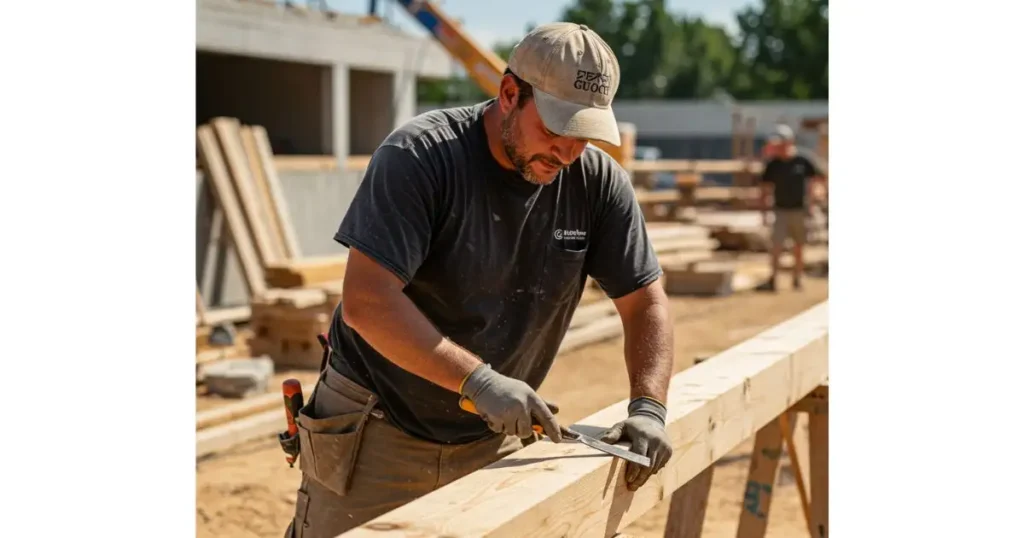Imagine building your dream house from scratch the foundation, the framing, all crafted by your own hands. But just like you wouldn’t trust an unlicensed doctor with your health, homeowners won’t trust an unlicensed carpenter with their home.
That’s where a Carpenter’s License comes in. It shows you have the skills, knowledge, and experience to handle big projects safely and professionally. In many states, it’s a must for lead carpenters or contractors on significant jobs.
This guide will walk you through how to become a licensed carpenter in five simple steps, covering typical requirements and offering tips to turn your passion into a thriving business.
Let’s get started!
Key Points for Getting Your Carpenter’s License
- Steps to Success: Becoming a licensed carpenter takes 5 clear steps, varying slightly by state.
- Training First: Start with vocational school or an apprenticeship to learn essential skills.
- Experience Matters: Most states require 2-4 years of hands-on work before licensing.
- License Proof: A carpenter’s license shows you’re a pro, often needed for big jobs.
- Time and Cost: Expect 3-5 years and $50-$500, depending on your state’s rules.
Table of Contents
What Is a Carpenter’s License?
A carpenter’s license is an official certification from your state government, allowing you to legally work as a carpenter. It demonstrates that you meet state standards for quality work, typically requiring experience and passing a written test.
However, the need for one varies. Some states mandate it for all carpentry work, while others, like California, require it for jobs over $500 (NextInsurance state guide). Others might only need a general contractor’s license for larger projects, creating a complex landscape of regulations.
For example, in Florida, major repairs like cabinet construction need a license, but minor fixes like door repairs might not (BizInsure state requirements). This variability underscores the importance of checking your state’s rules, which you can find on sites like Indeed’s career advice.
5 Steps to Become a Licensed Carpenter
The process, while varying by state, generally follows these five steps, as outlined in Huckleberry’s state-by-state guide:
Step 01: Get to Work
With your license, you can start taking on carpentry jobs, whether for an existing company or starting your own business. Remember to keep it current by renewing as required and staying on top of continuing education, which some states mandate for license renewal (Procore California guide).
Step 02: Get Training
The first step to becoming a carpenter is to learn the trade. Many aspiring carpenters opt for vocational schools or community college programs, which provide foundational skills such as working with wood, reading blueprints, and using tools safely.
These programs also allow students to explore specializations, including finish carpentry, which focuses on detailed trim work, and rough carpentry, which involves structural framing.
Apprenticeships, as noted in NEXT’s certification guide, also offer a blend of classroom learning and hands-on experience, often paying wages during training.
Step 03: Check Licensing Requirements
Once trained, research your state’s specific needs. This includes years of experience required, types of exams (business, law, or trade-specific), and fees.
For instance, California demands four years of experience for a C-5 or C-6 license (Contractor Nerd California). You can usually find this info on your state licensing board’s website, like CSLB for California.
Step 04: Gain Experience
Most states require on-the-job experience, often two to four years, before licensing. This is where you apply your training, working under licensed carpenters to learn from real-world projects.
For example, Hawaii requires four years of full-time experience within the last decade (CGA Connecticut report). It’s like an apprenticeship, building your skills through practice.
Step 05: Apply for Your State License
After meeting the requirements, submit your application. This typically involves filling out forms, providing proof of training and experience (like certificates or work references), paying fees (ranging from $50 to several hundred dollars), and passing exams.
Some states, like Florida, require a business and finance exam alongside a trade test (Lance Surety Bonds). It’s your chance to show you’re ready.
General Requirements and Costs
While steps vary, here’s a table summarizing common requirements across states, based on research from Workyard’s licensing overview:
| Requirement | Details |
|---|---|
| Pass Required Exams | Written or practical tests on carpentry skills, building codes, safety, business management. |
| Show Proof of Insurance | General liability and workers’ comp insurance, especially if employing others. |
| Pay Licensing Fees | Typically $50 to several hundred dollars, including application and exam fees. |
| Satisfy Miscellaneous | Age (usually 18+), high school diploma or GED, background check, valid ID. |
Costs can range from $50 for application fees in Hawaii to several hundred in California, with exam fees added to the total. Insurance, like $100,000 per person bodily injury in Hawaii, is another cost (CGA Connecticut report).
Typical Requirements

While details vary, here’s what you’ll likely need:
- Pass exams to prove your skills, covering safety and building codes.
- Show proof of insurance, like liability coverage, especially if you have employees.
- Pay fees, usually $50 to a few hundred dollars.
- Meet extra rules, like being 18, having a high school diploma, or passing a background check.
Unexpected Detail: State Variations
Did you know? Some states, like California, require a license for jobs over $500, while others, like Colorado, might not need one for small repairs. It’s a patchwork, so always check your state’s rules.
Timeframe and State Variations

Becoming licensed isn’t instant; it typically takes a few years. Training programs can last from months to years, depending on the type (vocational school vs. apprenticeship).
Experience requirements, like California’s four years, add to this (Best Trade Schools CA). The application process itself might take weeks to months, depending on exam scheduling and processing times.
An unexpected detail is the state-by-state patchwork: some, like Colorado, don’t require licenses for small repairs, while others, like California, mandate it for jobs over $500 (NextInsurance state guide).
This variability means checking local rules is crucial, especially for those moving states or starting new projects.
Tips for Becoming a Master Carpenter

Getting licensed is just the start. To excel, consider these tips, drawn from Concord Carpenter’s guide:
- Know Your Math: Carpentry involves measurements and calculations. Practice daily to get comfortable, using online resources or worksheets.
- Master Your Materials: Learn the properties of woods like pine (soft) or oak (tough), and hardware like screws. It helps choose the right materials for each job.
- Get to Know Your Tools: Read manuals for saws, drills, and sanders. Practice on scrap wood and always wear safety gear like goggles.
- Find a Mentor: Learn from experienced carpenters, whether a former boss or retired pro. They offer tips and feedback from years of real-world work.
These tips, combined with ongoing learning, can set you apart in the field.
Extra Requirements in Some States
Some states add extra hurdles, as noted in BizInsure’s state breakdown:
- Surety Bonds: Required in states like California ($25,000 bond) to protect clients if work isn’t completed properly.
- Business Name Registration: Many states, like Florida, require registering your business name, involving paperwork and fees.
- Financial Statements: Some, like Arkansas, ask for financial statements to prove you can run a business, ensuring stability.
These extras can add complexity, so plan.
How Long Does It Take to Become a Carpenter?
To illustrate, here’s a table summarizing the typical durations based on research from various sources:
| 2 to 4 years (if no license is needed) | Training Duration | Experience Required | Total Time (Approx.) |
|---|---|---|---|
| Vocational School + Experience | 6 months to 2 years | 2 to 4 years | 3 to 6 years |
| Apprentice Program | 3 to 4 years | Included in program | 4 to 4.5 years |
| On-the-Job Training Only | Varies (self-taught) | 2 to 4 years | 2 to 4 years (if no license needed) |
Note: The total time for licensed carpenters typically falls within 3 to 5 years, accounting for overlapping training and experience in apprentice programs.
FAQs and Related Resources
Do I need a license to be a carpenter?
It depends on your state. Some, like California, require it for jobs over $500; others, like Colorado, might not for small repairs.
How much does a carpenter’s license cost?
Fees range from $50 to a few hundred, plus exam costs, varying by state.
How long is the licensing process?
Typically a few weeks to months after meeting prerequisites, depending on exam scheduling and application processing.
Can I work without a license?
Possibly for minor jobs, but for major projects, a license is usually required to avoid legal issues.
What’s a carpenter’s license vs. a contractor’s license?
A carpenter’s license is for woodworking, while a contractor’s covers broader construction, like plumbing or electrical work.
Can I become a carpenter faster?
Yes, by choosing accelerated programs or states with shorter experience requirements, potentially reducing the time to 3 years.
How long does training take?
Training can range from a few months for short courses to 2 years for associate degrees, with apprentice programs taking 3 to 4 years.
Wrap-Up: Get Your Carpenter’s License
Getting your carpenter’s license is like nailing the perfect joint tricky at first, but so satisfying when it’s done. Follow these five steps, meet those carpentry license requirements, and you’re golden.
For related reading, check out articles like Best Way to Sharpen Carpenter Pencils and 5 Best Carpenter Pencil Sharpeners for tooltips, or 5 Best Carpenters Scribing Tools for precision marking advice, all part of a series on carpentry essentials.
This guide, inspired by Joist’s detailed blog, aims to equip you with the knowledge to succeed. Now, go build something amazing!







